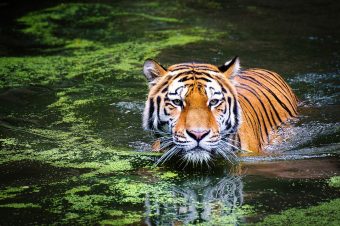
The tiger that leapt on Bhadai Tharu in the forests of Nepal took the sight from his left eye with a swipe of a paw. But it also helped the community leader understand that people must leave room for nature while pursuing economic development.
“The tiger attacked me because I went to his home. Otherwise, it never attacks humans,” says Tharu, who leads anti-poaching patrols in a forest in the Terai region, a stronghold of the big cats in the foothills of the Himalayas.
Terai is rich in wildlife. But it is also home to nearly eight million people who rely on its forests for everything from timber to medicine, and have cleared large areas for farming. That has led to environmental degradation, and put rhinos and elephants, as well as tigers, on the list of endangered species.
But in recent years, those pressures have eased under the Terai Arc Landscapes initiative. This government-led effort is helping to protect and restore Terai’s forests, reversing the loss of Nepal’s rich biodiversity and enhancing the benefits of intact ecosystems for the region’s people.
Launched in 2001, the initiative has secured habitat for threatened species including the greater one-horned rhinoceros and the Asian elephant as well as the royal Bengal tiger. A key element is the restoration of seven corridors to connect more strictly protected areas, including wildlife refuges in neighbouring India.
The corridors programme, with its measures to reduce human-wildlife conflict and support rural economies, was recently recognized as a United Nations World Restoration Flagship. Presented as part of the UN Decade on Ecosystem Restoration, the award showcases outstanding undertakings to restore ecosystems for the sake of both people and wildlife.
“The transboundary Terai Arc Landscape serves not only as a biological hotspot. It also serves as a true testament to the effectiveness of the landscape approach of conservation,” says Birendra Prasad Mahato, Minister of Forests and Environment of Nepal. “We are incredibly grateful for this recognition from the UN and are encouraged to continue tackling existing and new challenges faced by our forests, wildlife and communities.”
More:
- IBERIAN LYNX REBOUNDING THANKS TO CONSERVATION ACTION
- NATURE RESTORATION LAW: COUNCIL GIVES FINAL GREEN LIGHT
- THE WORLD’S CORALS ARE BLEACHING – HERE’S WHY
Himalayan hotspot
The Terai Arc Landscape initiative is reviving a biodiversity hotspot that covers 2.47 million hectares and is home to 7.5 million people. Many of its rural areas, especially those outside Nepal’s national parks, had been seriously degraded as a result of deforestation, fragmentation, encroachment and poaching.
Nature has quickly rebounded, capturing carbon, storing water and increasing the resilience of human and wildlife populations in the face of climate change. Camera traps and radio collars have helped detect tigers, elephants, rhinos, leopards, hyenas and many other species shuttling between previously isolated protected areas. These movements are helping to maintain genetic diversity and reduce the risk of extinction. Nepal’s tiger population has tripled, rising from 121 in 2009 to 355 in 2022, according to the latest national survey.
“The Terai Arc Landscape initiative does not protect nature by pulling people out of it but by bringing people and nature closer together,” says Inger Andersen, Executive Director of the United Nations Environment Programme (UNEP).
“After decades of uncontrolled exploitation and degradation, resources are now urgently needed to rebuild that connection and restore vital ecosystems. This is key to tackling climate change, biodiversity loss and rampant pollution,” Andersen says.
Source: UNEP

